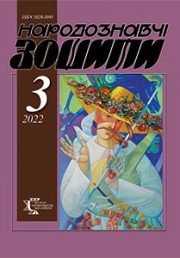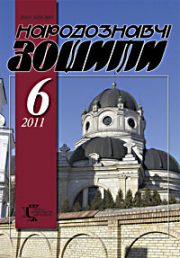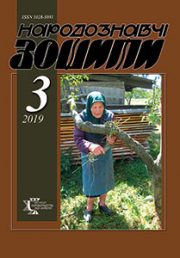The Ethnology Notebooks. 2019, № 4 (148), 787—806
УДК 37.091.011.3:94-051
DOI https://doi.org/10.15407/nz2019.04.787
FORMATION AND CONSOLIDATION OF NATIONAL POSITION OF HRYHORII DEMIAN
SOKIL Vasyl
ORCID ID: http://orcid.org/0000-0003-3164-1217
Doctor of Philology, Professor, Head of Department,
The Ethnology Institute National Academy of Sciences of Ukraine
Department of Folklore,
15, Svobody ave., 79000, Lviv, Ukraine.
Contacts: е-mail: vasylsokil@gmail.com
KOVAL Halyna
ORCID ID: http://orcid.org/0000-0002-2998-2357
Candidate of Philology, Senior Researcher,
The Ethnology Institute National Academy of Sciences of Ukraine
Department of Folklore,
15, Svobody ave., 79000, Lviv, Ukraine.
Contacts: е-mail: galyna.kov@gmail.com
Abstract. The proposed article is about the teacher, scientist, and political figure, Hryhorii Demian. He is a patriot, who has brought up not one generation of young followers that have preserved the best memories of him. In scientific environment, he is more known as a historian, folklorist, one of the few who devoted himself to studying the subject of rebellion. The study outlines the little investigated aspects of his life and activities — childhood and youth, family, and especially pedagogical work.
The formation of the views of H. Demian began with a rather large family. He left memories of his grandfather Oleksa Symsyichyn, his cousin Hryhorii Symsyichyn, his grandfather on the maternal line Fedir Ulynets. The latter handed over to H. Demian the «Gospel» of 1643 edition, which began his library collection. Warm memories formed the basis of memorials about his mother Mariia of the Savchyn family, and his father Vasyl Demian. He also mentioned his uncles Mykhailo Savchyn, Vasyl Kurylyshyn, and his aunt Hanna. In addition, information is provided about the brothers and sisters of H. Demian — Anna, Yeva, Ivan, Mariia, Anastasiia, Olha, Volodymyr, Sofia, Orysia, Vasyl.
The whole period of H. Demian’s education in the primary school in Hrabivka, then in Tukhla, Skole, and Slavske is revealed. The educational journey that began in Hrabivka, Pshanka in Skole district is described. Slavske period was extremely active; it was there that H. Demian engaged in national-patriotic education and upbringing of students at the lessons of history and extracurricular activities, including excursions, travels to places of outstanding people, historical events, and so on. Under the direction of H. Demian, the only optional course on the history of Ukrainian art in Ukraine was introduced. The school had a historical and ethnographic society. He was dismissed from work at Slavske high school (1974) because of his national-patriotic position.
Not less active for H. Demian was the period of pedagogical work at Verenchanka secondary school in Chernivtsi district (1974—1989). In the new place, he continued the well-elaborated educational and cognitive activity. There, H. Demian created a historical and ethnographic society, under the auspices of which the trips of outstanding places were carried out.
Keywords: biography, education, teacher, historical-ethnographic society, excursion, patriotic education.
Received 28.05.2019
REFERENCES
Dem’yan, H. (2011). Memoirs. Lviv [in Ukrainian].
Malyavs’kyy, Yu. (1963, 20 february). People from the mountains. Vil’na Ukrayina [in Ukrainian]. Dem’yan, H. (Ed.). (1996). Insurgent martyrologist of Skolivschyna. Skolivshchyna (pp. 301—725). L’viv: Instytut narodoznavstva NAN Ukrayiny [in Ukrainian].
Dem’yan, H. (2000). Fedir Onats. «Wind». Banderivtsi (Book 1, pp. 80—82). Kyiv: Ukrayins’ka Vydavnycha Spilka [in Ukrainian].
Hlushko, M. (1995). The feat of love is obsessed. Scientific activity of Grigory Demian. Khvyli Stryya (pp. 557—562). Stryy: Shchedryk [in Ukrainian].
Hlushko, M. (1999). «For Ukraine Live» (To the 70th anniversary of the birth of Gregory Demian). The Ethnology Notebooks, 3, 273—290 [in Ukrainian].
Sokil, H., & Sokil, V. (2009). Life and work for the establishment of the Ukrainian nation. The Ethnology Notebooks, 1—2, 4—13 [in Ukrainian].
Dem’yan, H. Employment history (copy) [in Ukrainian].
Dem’yan, H. Personal sheet of personnel accounting (copy) [in Ukrainian].
Pelens’ka, I. (1990). Educational life of Stryj. Stryyshchyna. Istorychno-memuarnyy zbirnyk (Vol. 1, pp. 390—404). N’yu-York; Toronto; Paryzh; Sidney [in Ukrainian].
Stefanyshyn, O. (1999, 7 april). Death Note: Iryna Demyan. Shlyakh peremohy [in Ukrainian]. Blazheyovs’kyy, D. (2004). Historical Shamyism of the Lviv Archdiocese (1832—1944) (Vol. 2, p. 319). L’viv [in Ukrainian].
Hvozdevych, S. (2009). Teacher from God. The Ethnology Notebooks, 1—2, 14—16 [in Ukrainian].
Pavlyuk, S. (2009). Civic obsession of Gregory Demyan. The Ethnology Notebooks, 1—2, 2—3 [in Ukrainian]. 805
Sirenko, V. (1966, 15 july). Surmies in the Carpathians. Reportage. Vil’na Ukrayina [in Ukrainian].
Bilonizhka, P., & Matkovs’kyy, P. (2014). Lazarenko Yevgeny Konstantinovich. L’viv natsional university of Ivan Franko: Encyclopedia (Vol. 2, pp. 21—22). L’viv: LNU imeni Ivana Franka [in Ukrainian].
Dem’yan, H. (1963, 30 march). According to Shevchenko places. Budivnyk komunizmu. Stryy [in Ukrainian].
Hovdysh, Y. (1973, 25 october). Frank’s paths. Radyans’ka Verkhovyna. Skole [in Ukrainian].
Yurkiv, V. (1971, 8 october). Forest paths. Radyans’ka Verkhovyna. Skole [in Ukrainian].
Dem’yan, H. (1972, 9 hrudnya). Skovorodinsky days in Slavske. Radyans’ka Verkhovyna. Skole [in Ukrainian].
Dem’yan, H. (1970). Classes on the history of Ukrainian art in rural schools. Radyans’ka shkola, 7, 83—88) [in Ukrainian].
Dem’yan, H. (2004). Family of scholars-folklorists. Vyzvol’nyy shlyakh (Book 4, pp. 40—42) [in Ukrainian].
Dem’yan, H. (2007). Peredmova. In Dem’yan, H. Grabovets: historical and ethnographic research (pp. 3—5) [in Ukrainian].
Korolishyn, S. (1990, 22 june). «I was a non grata person» Radyans’ka Verkhovyna. Skole [in Ukrainian].
Kostyk, M. (1976, 19 february). Eye-to-face with the wonders of beauty and science. Prapor peremohy. Zastavna [in Ukrainian].
Dem’yan, H. (1977, 15 january). At the home of the great Kamenyar. Prapor peremohy. Zastavna [in Ukrainian].
Dem’yan, H. (1977, 21 may). Among the Hutsul pearls. Prapor peremohy. Zastavna [in Ukrainian].
Dem’yan, H. (1980). Use of chronological cards in literature lessons Ukrayins’ka mova i literatura v shkoli, 3, 38—43) [in Ukrainian].
Dem’yan, H.V. (1988). School Society for the Study of Folklore, Ethnography and Local History. Folk Art and Ethnography, 3, 52—55 [in Ukrainian].
Kostyk, V., & Kostyk, L. (2018). Born in bulk. Iryna Vil’de (1907—1982). Bibliohrafichnyy pokazhchyk (pp. 3—12). Chernivtsi [in Ukrainian].
Dem’yan, H. (1988). Autographs-wishes by Irina Vilde on the occasion of her 50th anniversary. Materials of archive (Ark. 109—115) [in Ukrainian].
Dem’yan, H. (1988, 2 february). Lessons for All Life. Prapor peremohy. Zastavna [in Ukrainian].
Kassaraba, M. (2009). Work for the benefit of Ukrainian culture. The word about the prominent historian and folklorist Gregory Demyan. The Ethnology Notebooks, 1—20, 19—26 [in Ukrainian].







